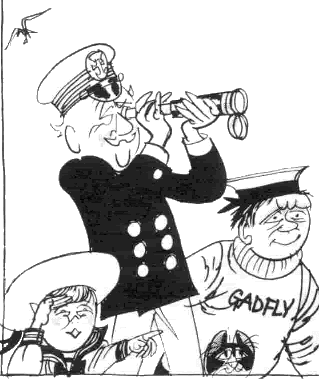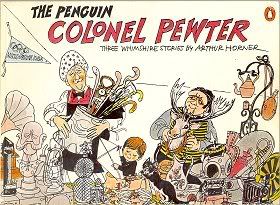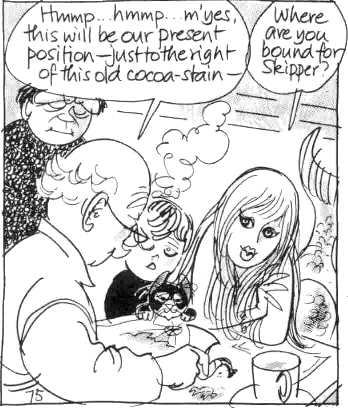

 When I was growing up, I remember my father talking about a strip that he'd enjoyed some years ago in The Age newspaper, Colonel Pewter. He talked about various of the characters, including Glub, Colonel Pewter's Neanderthal butler, who Pewter dug out of his grounds where he'd been quick-frozen in Upper Palaeolithic times, Pewter's great-nephew Martin, and his cook-housekeeper Mrs. Aspic. Colonel Pewter had apparently run for 18 years, from 1952 to 1970, in a range of newspapers in England and Australia.
When I was growing up, I remember my father talking about a strip that he'd enjoyed some years ago in The Age newspaper, Colonel Pewter. He talked about various of the characters, including Glub, Colonel Pewter's Neanderthal butler, who Pewter dug out of his grounds where he'd been quick-frozen in Upper Palaeolithic times, Pewter's great-nephew Martin, and his cook-housekeeper Mrs. Aspic. Colonel Pewter had apparently run for 18 years, from 1952 to 1970, in a range of newspapers in England and Australia.
A year or two later, The Age started reprinting the Colonel Pewter series where Glub runs in the Olympic Games, I think in the runup to the Moscow Olympic Games in 1980. Not only that, but Arthur Horner, the mysterious man behind this fantastic strip, suddenly re-emerged with the satirical Uriel Report, about an angel observing modern events, and many additional political cartoons (he moved back to Australia from England in 1976).
For information about the artist himself, a good place to start is a fine article written by his daughter Jane Sullivan, herself a well-known journalist and writer, in The Age, March 1997 (scroll down for the Arthur Horner tribute). Another excellent tribute is his Obituary by Les Tanner. Both give some interesting insights into the working methods of Horner and his attitudes regarding his work and characters in general.
Colonel Pewter's adventures were initially published in Britain, beginning in the News Chronicle(1952), The Daily Mail(after a takeover in 1960), and later in The Guardian (1964-1970). Horner was Australian, but as he lived at various times in England and Australia, the appearance of the strip in both countries isn't surprising. The entire run appeared in The Age, here in Melbourne.
 There have been three compilations of Colonel Pewter stories (plus a major guest appearance in a fourth book) and they're a good starting point for anyone interested in finding out more, though they don't begin to cover these myriad extraordinary adventures.
There have been three compilations of Colonel Pewter stories (plus a major guest appearance in a fourth book) and they're a good starting point for anyone interested in finding out more, though they don't begin to cover these myriad extraordinary adventures.
 When I first started reading Colonel Pewter, it seemed to me these tales - and in some ways, his character - were linked to Lord Dunsany's eccentric (also sadly forgotten) short story character, Jorkens - always able to spin stories that began in the commonplace and went somewhere else altogether. In a sense, I feel that Daniel Reed's current Australian comic, The Crumpleton Experiments continues this tradition - albeit in a much darker form - with Professor Crumpleton being a British eccentric with much in common with both Pewter and Jorkens.
When I first started reading Colonel Pewter, it seemed to me these tales - and in some ways, his character - were linked to Lord Dunsany's eccentric (also sadly forgotten) short story character, Jorkens - always able to spin stories that began in the commonplace and went somewhere else altogether. In a sense, I feel that Daniel Reed's current Australian comic, The Crumpleton Experiments continues this tradition - albeit in a much darker form - with Professor Crumpleton being a British eccentric with much in common with both Pewter and Jorkens.
 In Ironicus is an early four part epic from 1953-54, which introduces the "Holdall," a magical bag that can contain anything, including Pewter's flying bicycle. Ironicus itself is a strange land of talking animals, and the strips mostly appeared in blocks of three.
In Ironicus is an early four part epic from 1953-54, which introduces the "Holdall," a magical bag that can contain anything, including Pewter's flying bicycle. Ironicus itself is a strange land of talking animals, and the strips mostly appeared in blocks of three.
 The stories often centre around provincial British settings and characters, though with an unusual twist. Some of the regular cast (in addition to Martin, Glub and Mrs. Aspic) are Chloe the cat; Sirius the telepathic half space-dog; intellectual couple the Pinyons (pictured); the Reverend Crumble, Rector of St. Vitus; Lord Crombleigh Parjit and Fleet Street reporter Wesley Upchat.
The stories often centre around provincial British settings and characters, though with an unusual twist. Some of the regular cast (in addition to Martin, Glub and Mrs. Aspic) are Chloe the cat; Sirius the telepathic half space-dog; intellectual couple the Pinyons (pictured); the Reverend Crumble, Rector of St. Vitus; Lord Crombleigh Parjit and Fleet Street reporter Wesley Upchat.
Many of the stories are fully-fledged wild adventure yarns, akin to Carl Barks' masterful, consistently amazing and engaging Donald Duck/Uncle Scrooge stories, or Herge's Tintin (though the latter is certainly far more grounded in reality). Like these artists, Horner had a seemingly limitless imagination and amazing dexterity of vision and technique in the comics medium. Like these artists he was also incredibly consistent, producing tale after tale, year after year, across a span of decades.
The most marvellous aspect of the stories for me - apart from the fact that the material was perfect for comic strip presentation - was the way it managed to present stories that were at once continuing yarns and also funny on a daily basis. The stories themselves were centred always around well-rendered characters, who were believable, however bizarre and wild the adventures became. Of course, some of the attitudes (as with some Barks material) reflect the times, but they still hold up remarkably well.
 The satirical aspects of the strip caused controversy at times, such as the initial Glub series - Into the Ice Age (1955), which sent up the prevailing conservatism of much of British society of the time, with Glub as the innocent abroad in this strange world - and led to the series being cancelled for a while. Other early tales include Far Journey (1954-55) in which Pewter and Co. find themselves in a rocket that lands on the Moon. Tales often featured mythical characters, such as Francis the invisible Piggin (1956) and Melusine the mermaid (who puts in a few appearances).
The satirical aspects of the strip caused controversy at times, such as the initial Glub series - Into the Ice Age (1955), which sent up the prevailing conservatism of much of British society of the time, with Glub as the innocent abroad in this strange world - and led to the series being cancelled for a while. Other early tales include Far Journey (1954-55) in which Pewter and Co. find themselves in a rocket that lands on the Moon. Tales often featured mythical characters, such as Francis the invisible Piggin (1956) and Melusine the mermaid (who puts in a few appearances).
Terry Lane, in the introduction to The Book of Uriel wrote:
In 1977 the Victorian Ministry of the Arts mounted a handsome exhibition of Horner's drawings, some of them not quite complete and still showing the lines he uses to shape his compositions, which are removed in the final printed work. It was like seeing the artist's work in progress and it demonstrated the careful attention to composition and the manner in which he builds up the rich detail in each frame.
 The National Library of Australia holds the originals of about a dozen series of strips in its collections, many of which are apparently in poor condition, but editing and republishing some of these at some point would be worthwhile, I think (I'd certainly be interested in being involved in such a project).
The National Library of Australia holds the originals of about a dozen series of strips in its collections, many of which are apparently in poor condition, but editing and republishing some of these at some point would be worthwhile, I think (I'd certainly be interested in being involved in such a project).
I'd be interested in hearing from Colonel Pewter fans, so please feel free to email me or, better yet, join the Colonel Pewter Yahoo Group! I was pretty amazed that no website existed already for this strip at the time I made it - it remains a work in progress.
>Special thanks to: Guido Susts, John East, Martin Foot, Simon Alsop, Myles Fisher, Chris Owens, Alan McCutcheon, Malcolm Clark, Paul Gravett, Peter Beckwith, Bob Corcoran, Michael Howes, Mick Stone and several others (please remind me, if I missed you!)
© Copyright: pictures - Arthur Horner, text - Ian C. Thomas, 2005. No reproduction without prior written consent and acknowledgment
Return to Ian Thomas Graphics main page.